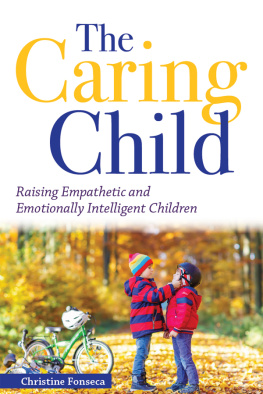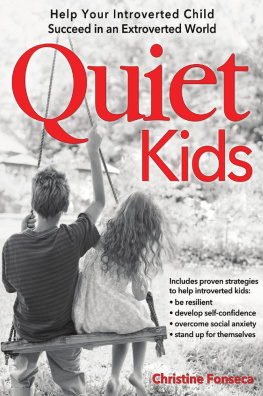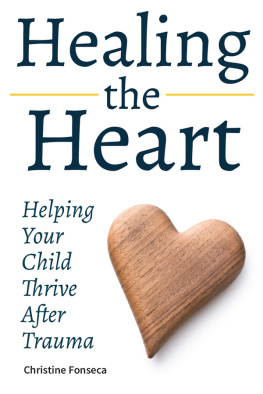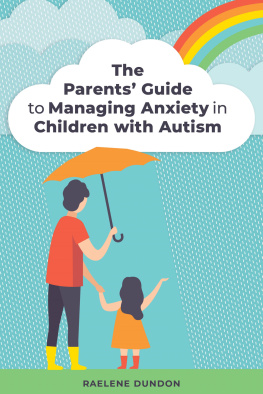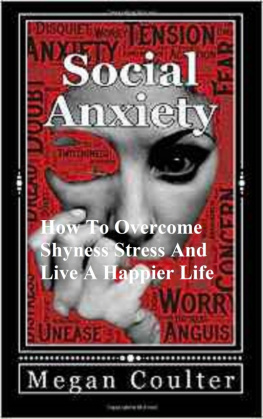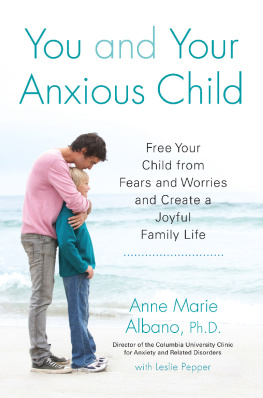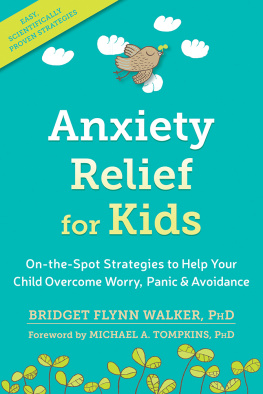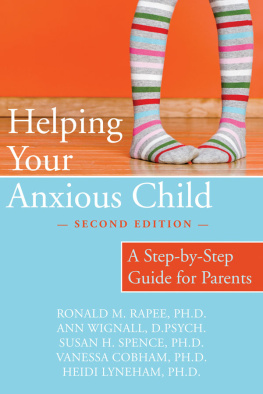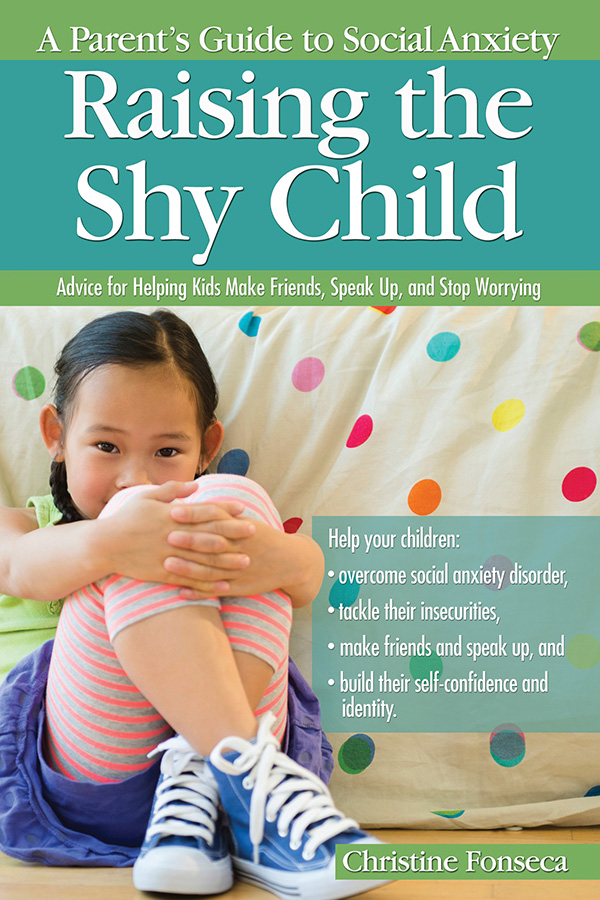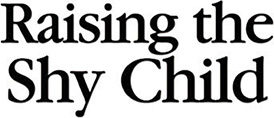

Dedication
This book is for everyone who felt too shy and too scared to face the day. I promise brighter times are possible.
Copyright 2015 Prufrock Press, Inc.
Edited by Lacy Compton
Layout design by Raquel Trevino
ISBN-13: 978-1-61821-400-3
The purchase of this book entitles the buyer to reproduce activity pages for individual use only. No other part of this book may be reproduced, translated, stored in a retrieval system, or transmitted, in any form or by any means, electronic, mechanical, photocopying, microfilming, recording, or otherwise, without written permission from the publisher.
At the time of this books publication, all facts and figures cited are the most current available; all telephone numbers, addresses, and website URLs are accurate and active; all publications, organizations, websites, and other resources exist as described in this book; and all have been verified. The authors and Prufrock Press make no warranty or guarantee concerning the information and materials given out by organizations or content found at websites, and we are not responsible for any changes that occur after this books publication. If you find an error or believe that a resource listed here is not as described, please contact Prufrock Press.

| Prufrock Press Inc.
P.O. Box 8813
Waco, TX 76714-8813
Phone: (800) 998-2208
Fax: (800) 240-0333
http://www.prufrock.com |
Table of Contents
Acknowledgements
Writing is never a solitary sport. And bringing to life a book like this always takes the help of many in order to make it relevant. This list Im certain is not exhaustive, but it does represent those without whom this book would not exist.
To Lacy Compton and the team at Prufrock Pressonce again your support, encouragement, and insistence on quality continues to grow my art and provide a platform from which I can help others. Thank you hardly seems adequate!
To my writing partner, Michelle McLeanonce again I must thank you for dropping what youre doing and taking a few moments to read and provide suggestions on another one of my books. One day Ill figure out how to repay you for this!
To my real-life BFFs and cheer squad: Jodi, Kelley, Nancy, Jill, Corrine, Joe, Debbi, and AndreaYou are all such amazing friends and supporters of what I strive to do on a daily basis. Thank you for being willing to share stories, lend an ear, and just help when I need it. Trust me when I say that it never goes unnoticed.
To Nancy Lewis and Jodi CurtisThank you for the last minute information on all things speech and language related and for pointing me in the right direction for some resources. I am so fortunate to be surrounded by such talent every day.
To the hundreds of contributors from more than five countriesYour stories filled these pages and made my words more relevant than they would have been otherwise. Thank you for allowing me to be part of your lives and sharing your struggles and triumphs, your opinions, and questions. Although there were too many of you to name specifically, I do want to send a special shout-out to Erin, Gina, Sarah, Brittany, and the others who wished to remain anonymous in the book. You guys are fearless. Thank you!
To the endless sea of support from the writing community, the bloggers, readers, and fangirls I never dreamed Id haveI havent met most of you in real life, but wowza! You guys are really amazing. Your encouragement and understanding of the industry we all love is nothing short of amazing.
Finally, my acknowledgements are never complete without a personal thank you to my family, both immediate and extended.
To Dirck, Fabiana, and ErikaYou are my life. Period. None of this would happen without your support and willingness to share me with my stories and my readers.
To my extended familyThanks for making sure my hubby and kids dont feel too neglected when Im under deadline. Thank you, also, for reminding me that there is a life beyond my books! The balance means everything. And no, Im really not as stressed as I may seem from time to time!
Christine Fonseca
Authors Note
As a practicing school psychologist, I have been on the frontline of the mental health crisis facing many school-aged children for almost two decades. These children increasingly suffer from mental health concerns inadequately addressed in private or public sectors, often resulting in significant impacts to educational functioning.
Perhaps the most common mental health concerns I deal with in my daily job are anxiety and social phobia. Ranging from the mild case of performance anxiety to the more significant bouts of school refusal, agoraphobia, and selective mutism, children from kindergarten through high school are stretched to their limits. Theyre asked to demonstrate coping skills beyond their capacity in order to deal with our ever-increasing stressful world, often with disastrous results that include increased school refusal, behavioral problems, suicidal ideations, and reduced resiliency.
Most of my work with parents, educators, and children has focused on developing strategies for daily use to negate the negative impact caused by everyday stress. Through this work, Ive witnessed the lack of information for parents regarding the causes and treatment of anxiety in general, and social anxiety more specifically. Without this information, parents are left to feel hopeless in the face of their childrens resistance toward building friendships, lack of self-advocacy, and school refusal.
It is my goal that this book will provide some of the much needed answers in this area. Based on both my professional experience and the most recent, though limited, research on social anxiety in children and adolescents, this book strives to put into user-friendly language the science behind social anxiety. In addition, Ive collected the best evidence-based interventions and tips to provide parents and children with the tools needed to end their cycle of embarrassment and humiliation and develop the skills needed in our complex social world.
Finally, it is my desire that anyone dealing with social anxiety knows that he or she is not alone in this struggle. As one of my contributors to this project said, Before I knew I had the disorder, I (had) never met anyone with it, or knew it had a name. Ive included case studies and direct quotes from the people impacted by social anxiety disorder throughout the book. Although I have changed the names and any identifying information to protect the participants anonymity, it is my hope that these real-world stories will remind readers confronted with the issues presented in this book that they are not alone.
I want to extend a quick thanks to those individuals brave enough to share their thoughts, their stories, and their time with me. Social anxiety is a challenging beast. My hope is that with increased knowledge and understanding, we can find a way past the fear together.
Christine Fonseca
Introduction
Clutching her hands, nervously biting his lips, repeatedly checking her phonetake a look around any school hallway during passing periods, and chances are youll find a few students demonstrating these or similar signs of building anxiety. Look harder, and you may find a few that are rocking back and forth, hiding, or silently crying in the bathroom, indications of more significant levels of anxiety and fear. An estimated 9%12% of the population (children, adolescents, and adults) is affected by social anxiety either by itself or alongside other mental health concerns (Ruscio et al., 2008; Wittchen, Stein, & Kessler, 1999). Furthermore, social anxiety disorder has been identified as one of the most common mental health concerns in children and adolescents after depression and substance abuse (Bernstein, 2014; Kashdan & Herbert, 2001). Despite its prevalence, social anxiety is one of the least researched, diagnosed, and treated mental health conditions (Kashdan & Herbert, 2001), especially in children and adolescents.


